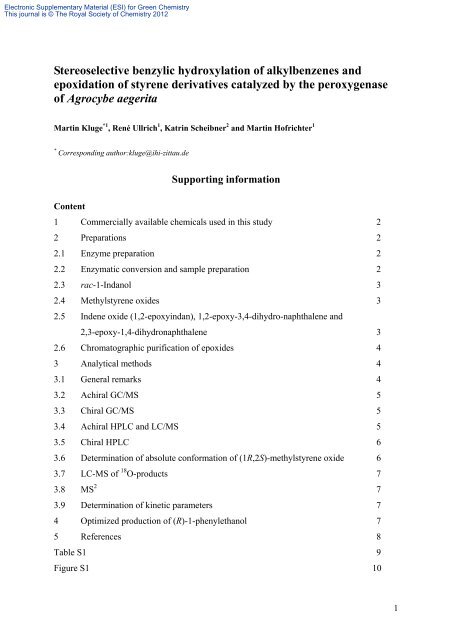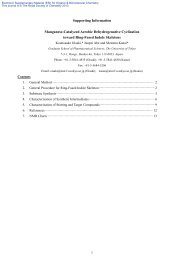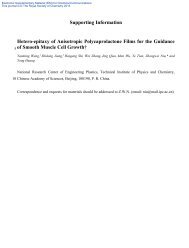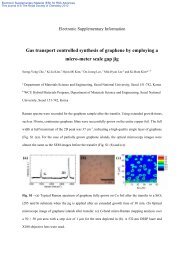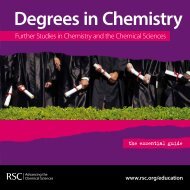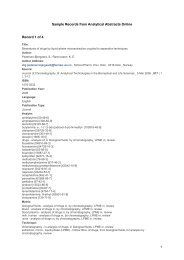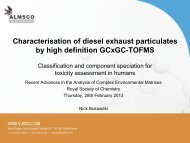Stereoselective benzylic hydroxylation of alkylbenzenes and ...
Stereoselective benzylic hydroxylation of alkylbenzenes and ...
Stereoselective benzylic hydroxylation of alkylbenzenes and ...
You also want an ePaper? Increase the reach of your titles
YUMPU automatically turns print PDFs into web optimized ePapers that Google loves.
Electronic Supplementary Material (ESI) for Green Chemistry<br />
This journal is © The Royal Society <strong>of</strong> Chemistry 2012<br />
<strong>Stereoselective</strong> <strong>benzylic</strong> <strong>hydroxylation</strong> <strong>of</strong> <strong>alkylbenzenes</strong> <strong>and</strong><br />
epoxidation <strong>of</strong> styrene derivatives catalyzed by the peroxygenase<br />
<strong>of</strong> Agrocybe aegerita<br />
Martin Kluge *1 , René Ullrich 1 , Katrin Scheibner 2 <strong>and</strong> Martin H<strong>of</strong>richter 1<br />
* Corresponding author:kluge@ihi-zittau.de<br />
Supporting information<br />
Content<br />
1 Commercially available chemicals used in this study 2<br />
2 Preparations 2<br />
2.1 Enzyme preparation 2<br />
2.2 Enzymatic conversion <strong>and</strong> sample preparation 2<br />
2.3 rac-1-Indanol 3<br />
2.4 Methylstyrene oxides 3<br />
2.5 Indene oxide (1,2-epoxyindan), 1,2-epoxy-3,4-dihydro-naphthalene <strong>and</strong><br />
2,3-epoxy-1,4-dihydronaphthalene 3<br />
2.6 Chromatographic purification <strong>of</strong> epoxides 4<br />
3 Analytical methods 4<br />
3.1 General remarks 4<br />
3.2 Achiral GC/MS 5<br />
3.3 Chiral GC/MS 5<br />
3.4 Achiral HPLC <strong>and</strong> LC/MS 5<br />
3.5 Chiral HPLC 6<br />
3.6 Determination <strong>of</strong> absolute conformation <strong>of</strong> (1R,2S)-methylstyrene oxide 6<br />
3.7 LC-MS <strong>of</strong> 18 O-products 7<br />
3.8 MS 2<br />
7<br />
3.9 Determination <strong>of</strong> kinetic parameters 7<br />
4 Optimized production <strong>of</strong> (R)-1-phenylethanol 7<br />
5 References 8<br />
Table S1 9<br />
Figure S1 10<br />
1
Electronic Supplementary Material (ESI) for Green Chemistry<br />
This journal is © The Royal Society <strong>of</strong> Chemistry 2012<br />
1 Commercially available chemicals used in this study<br />
(In alphabetical order for each supplier): tert-butylbenzene, mCPBA (m-chloroperbenzoic<br />
acid) 2-indanol, indene, trans-β-methylstyrene, (S,S)-methylstyrene oxide ((2S,3S)-2-methyl-<br />
3-phenyloxirane), phenylacetaldehyde, 1-phenylethanol, 1-phenylpentanol, 2-phenyl-2-<br />
propanol, styrene oxide, 4-oxo-TEMPO (2,2,6,6-tetramethyl-4-oxo-piperidin-1-oxy), α-<br />
tetralone, β-tetralone, 1-tetralol (1,2,3,4-tetrahydro-1-naphthol) (Aldrich); acetonitrile<br />
(MeCN), CHCl3, CH2Cl2, peracetic acid, styrene, (R)-(+)-1-phenylethanol, (S)-(-)-1phenylethanol,<br />
2-phenylethanol, i-PropOH (Merck); acetophenone, indan, (S)-(+)-1-indanol,<br />
ethylbenzene, pentylbenzene, (S)-(-)-1-phenylpropanol, propylbenzene, tetralin (1,2,3,4terahydronaphthalene)<br />
(Fluka); L-(+)-ascorbic acid (Riedel de Haen); butylbenzene<br />
(Supelco); cumene, 1,2-dihydronaphthalene, 1,4-dihydronaphthalene, 1,4-epoxy-1,2-<br />
dihydronaphthalene, 1-hydroxyindan, α-methylstyrene, α-methylstyrene oxide (2-methyl-2-<br />
phenyloxirane), cis-β-methylstyrene, propiophenone, (S)-(+)-1-tetralol ((S)-(+)-1,2,3,4-<br />
tetrahydro-1-naphthol) (TCI Europe). 18 O-labeled hydrogen peroxide was obtained from<br />
ICON Isotopes (Summit, NJ).<br />
2 Preparations<br />
2.1 Enzyme preparation<br />
The peroxygenase <strong>of</strong> Agrocybe aegerita (AaeAPO) was purified by several steps <strong>of</strong><br />
ultrafiltration <strong>and</strong> ion exchange chromatography. 1 The final AaeAPO preparation (main<br />
is<strong>of</strong>orm II) had a specific activity <strong>of</strong> 120 U mg -1 related to the oxidation <strong>of</strong> veratryl alcohol; 2<br />
one unit <strong>of</strong> AaeAPO per mL (1 U mL -1 ) refers to an enzyme concentration <strong>of</strong> 0.31 µM.<br />
2.2 Enzymatic conversion <strong>and</strong> sample preparation<br />
Enzymatic conversions were carried out in a total volume <strong>of</strong> 1.0 mL in 1.5-mL HPLC vials<br />
vigorously magnetically stirred at room temperature (RT). Reaction was started by addition <strong>of</strong><br />
20 µL <strong>of</strong> an appropriately diluted AaeAPO preparation to the receiver. The receiver consisted<br />
<strong>of</strong> potassium phosphate buffer pH 7 (10 mM final concentration), substrate <strong>and</strong> hydrogen<br />
peroxide (both at 1.0 mM final concentration). To ensure substrate solubility, the reaction<br />
mixture contained 20% (vol/vol) acetonitrile (MeCN). After 10 min, the reaction was<br />
assumed to be completed <strong>and</strong> products immediately analyzed by HPLC. For GC/MS analysis,<br />
samples were slightly acidified (not in case <strong>of</strong> olefins due to instability <strong>of</strong> the expected<br />
epoxides) <strong>and</strong> intensively mixed with 200 µL <strong>of</strong> CH2Cl2 for one hour. Then the CH2Cl2<br />
extracts were used for GC/MS analysis without further treatment.<br />
2
Electronic Supplementary Material (ESI) for Green Chemistry<br />
This journal is © The Royal Society <strong>of</strong> Chemistry 2012<br />
2.3 rac-1-Indanol<br />
Enantiomerically pure (S)-(-)-1-indanol was racemized after a modified method <strong>of</strong> Wuyts et<br />
al. using hydrochloric acid to an enantiomeric excess less than 5% S-(-)-1-indanol. 3<br />
2.4 Methylstyrene oxides<br />
Racemic epoxides <strong>of</strong> α-methylstyrene, cis-β-methylstyrene <strong>and</strong> trans-β-methylstyrene were<br />
obtained from a conformationally conservative Prileshayew synthesis after Hibbert <strong>and</strong> Burt<br />
modified using the respective methylstyrene <strong>and</strong> 0.5 M peracetic acid in CHCl3 at 0°C (kept<br />
overnight). 4 The organic phases were washed with alkali <strong>and</strong> water. Then aliquots were mixed<br />
with 20% by volume MeCN <strong>and</strong> CHCl3 was evaporated in large part at RT. The residue was<br />
taken up in an aqueous mobile phase (resulting in app. 45% MeCN) <strong>and</strong> purified by HPLC to<br />
obtain a racemic st<strong>and</strong>ard sample. β-Methylstyrene oxide diastereomers were separated by<br />
achiral GC/MS <strong>and</strong> compared with an authentic st<strong>and</strong>ard <strong>of</strong> (S,S)-trans-β-methylstyrene<br />
oxide. The earlier eluting cis-isomer gave a 70 eV mass spectrum very similar to that <strong>of</strong> the<br />
authentic trans-isomer showing the same fragments in slightly varied intensities. α-<br />
Methylstyrene oxide was confirmed by achiral GC/MS in comparison to an authentic<br />
st<strong>and</strong>ard.<br />
2.5 Indene oxide (1,2-epoxyindan), 1,2-epoxy-3,4-dihydronaphthalene <strong>and</strong> 2,3-epoxy-<br />
1,4-dihydronaphthalene<br />
Indene oxide <strong>and</strong> dihydronaphthalene oxides were prepared in a similar manner as<br />
methylstyrene oxides from indene <strong>and</strong> the respective dihydronaphthalenes using mCPBA<br />
instead <strong>of</strong> peracetic acid in CH2CL2 <strong>and</strong> treated equally to receive racemic st<strong>and</strong>ard samples.<br />
MS 2 mass spectroscopy <strong>of</strong> the three epoxides in 50% (vo/vol) MeCN aqueous solution<br />
revealed quasi-molecular ions [M-H] + (133 <strong>and</strong> 147 m/z) <strong>and</strong> several adduct ions [M-MeCN-<br />
H] + (+41 m/z). The processing <strong>of</strong> the respective isolated MeCN adduct ions revealed the<br />
molecular ions [M] + . Both [M] + <strong>and</strong> [M-H] + gave a common fragment series <strong>of</strong> mass losses <strong>of</strong><br />
M -17 m/z, -27 m/z <strong>and</strong> -29 m/z presumably referring to the loss <strong>of</strong> hydroxyl, vinyl <strong>and</strong><br />
formyl for both epoxides. 1,4-Dihydronaphthalene oxide was further analyzed by GC/MS <strong>and</strong><br />
its mass spectrum was aligned with literature data. 5<br />
2.6 Chromatographic purification <strong>of</strong> epoxides<br />
3
Electronic Supplementary Material (ESI) for Green Chemistry<br />
This journal is © The Royal Society <strong>of</strong> Chemistry 2012<br />
In order to acquire racemic st<strong>and</strong>ard samples <strong>of</strong> epoxides, a purification method was<br />
developed based on the analytical resolution <strong>of</strong> epoxides on the same column as mentioned<br />
below (section 3.4). Methodology is briefly exemplified for cis-β-methylstyrene oxide.<br />
Injections <strong>of</strong> up to 100 µL <strong>of</strong> the product mixture in aqueous phase (~45% MeCN) were<br />
accomplished. Chromatographic starting conditions were the same as for analytical resolution.<br />
One <strong>and</strong> a half column volume prior to trans-β-methystyrene oxide (impurity) elution a linear<br />
gradient was run to 70% MeCN from 10.4 to 11.0 min. Flow was reduced to 0.02 mL min -1 at<br />
13.0 min to concentrate the desired cis-isomer eluting in a huge peak within app. 10 to 20 min<br />
depending on the injection volume. After elution <strong>of</strong> that peak the flow was set to 0.5 mL min -1<br />
again <strong>and</strong> residual substances were removed from the column with 95% MeCN. Fractions<br />
whose 258 nm UV signal was greater than 200 mAU were collected. The combined fractions<br />
were re-chromatographed <strong>and</strong> found to be homogenous containing only cis-β-methylstyrene<br />
oxide but not the trans-diastereomer as illustrated in figure S1. Other epoxides were collected<br />
in a similar way.<br />
3 Analytical methods<br />
3.1 General remarks<br />
Identification <strong>of</strong> reaction products was achieved by comparing them with authentic st<strong>and</strong>ards<br />
using chromatographic separation as well as UV/Vis <strong>and</strong> MS detection methods. Mass<br />
spectral analysis was assisted by automated NIST library search. To determine absolute<br />
configuration <strong>and</strong> enantiomeric excess (ee), racemic as well as immixtures <strong>of</strong> enantiomers <strong>of</strong><br />
known ee were resolved by GC or HPLC <strong>and</strong> elution orders were compared or assigned to<br />
literature. To quantify the ee, peak areas <strong>of</strong> enantiomers served for calculation. Signals used in<br />
HPLC were specific UV-traces <strong>of</strong> 4 nm b<strong>and</strong>width whereas for mass spectrometry, the<br />
extracted trace <strong>of</strong> the most intensive substance related ion was evaluated. In the case <strong>of</strong> indene<br />
oxide no baseline separation was obtained in chiral separation by HPLC. Therefore peak<br />
height ratio <strong>of</strong> the sample was compared to that <strong>of</strong> a racemic mixture.<br />
Determination <strong>of</strong> 18 O-incorporation was accomplished using molecular ion peaks obtained<br />
from achiral GC/MS with 70 eV EI <strong>and</strong> APCI-LC/MS. 18 O-incorporation is expressed by the<br />
ratio <strong>of</strong> intensities <strong>of</strong> the 18 O isotopic peak to the sum <strong>of</strong> 16 O <strong>and</strong> 18 O isotopic peaks.<br />
Liquid <strong>and</strong> gas chromatography was performed on achiral <strong>and</strong> chiral phases coupled to mass<br />
spectrometry as described below.<br />
4
Electronic Supplementary Material (ESI) for Green Chemistry<br />
This journal is © The Royal Society <strong>of</strong> Chemistry 2012<br />
3.2 Achiral GC/MS<br />
Aliquots <strong>of</strong> 1 µL <strong>of</strong> the separated organic phase were injected into the GC. To clarify reaction<br />
products, gas chromatography/mass spectroscopy was performed on an Agilent 6890 model<br />
gas chromatograph equipped with a 5793 mass selective detector using a Zebron ZB 1701 (30<br />
m × 0.25 mm ID × 0.25 µm film thickness, Phenomenex) capillary column at a flow rate <strong>of</strong><br />
1.5 mL min -1 helium. Injection was accomplished in split mode at 280°C <strong>and</strong> a temperature<br />
program was run from 60°C attended for 4 min <strong>and</strong> raised with 20°C min -1 to 280°C held for<br />
5 min. 70 eV EI mass spectra were recorded from 40 to 300 m/z in 0.1 m/z step size at a rate<br />
<strong>of</strong> app. 1 Hz.<br />
3.3 Chiral GC/MS<br />
To resolve respective enantiomers, chiral gas chromatography / mass spectroscopy was<br />
performed on a Varian 3800 Chrompack model gas chromatograph using a beta-DEX 120<br />
chiral analytical capillary column (30 m × 0.25 mm ID × 0.25 µm film thickness, Supelco)<br />
possessing good selectivity for medium-size enantiomers. Carrier gas was helium at a<br />
constant flow rate <strong>of</strong> 1.5 ml min -1 . Injection was accomplished in the temperatureprogrammed<br />
vaporization (TPV) mode starting at 80°C to exclude the solvent in large part.<br />
Transfer <strong>of</strong> analytes to the column was accomplished with split ratios <strong>of</strong> 2 to 10 while heating<br />
the injector with 200°C min -1 to a point 20°C greater than the individual substance-dependent<br />
separation column temperature at which chiral resolution was taking place most efficiently. A<br />
column temperature program was run starting with an initial temperature <strong>of</strong> 80°C that was<br />
held during the transfer <strong>and</strong> increased at a rate <strong>of</strong> 50 °C min -1 up to the initial separation<br />
temperature followed by an increase <strong>of</strong> 0.2°C min -1 until 3 min after the enantiomers had<br />
eluted. Initial column separation temperatures for 1-phenylethanol, 1-phenylpropanol, 1phenylbutanol,<br />
1-tetralol <strong>and</strong> 1-indanol were 123°C, 132°C, 146°C, 136°C <strong>and</strong> 115°C<br />
respectively. For styrene oxide, cis- <strong>and</strong> trans-β-methylstyrene oxide these temperatures were<br />
127°C, 110°C <strong>and</strong> 118°C, respectively.<br />
The GC was connected to a Saturn 2000 ion trap mass spectrometer operating in 70 eV EI<br />
scanning mode. Mass spectra were recorded from 40 to 300 m/z with variable ionization time<br />
at a rate <strong>of</strong> app. 1 Hz.<br />
3.4 Achiral HPLC <strong>and</strong> LC/MS<br />
HPLC was performed on a 1200 Series Agilent liquid chromatograph. A UV-Vis diode array<br />
detector was connected recording absorption spectra in a range from 210 to 400 nm in 1 nm<br />
5
Electronic Supplementary Material (ESI) for Green Chemistry<br />
This journal is © The Royal Society <strong>of</strong> Chemistry 2012<br />
step size. Routinely, a Gemini C6-Phenyl analytical column (150 × 2.1 mm × 3 µm,<br />
Phenomenex, 50°C) was used. A mixture <strong>of</strong> 10 mM phosphoric acid <strong>and</strong> MeCN was run at<br />
0.35 mL min -1 starting from 20% MeCN that was held over 3 min followed by a linear ramp<br />
to 85% MeCN within 15 min <strong>and</strong> attended there for additional 3 min. To resolve indanol<br />
isomers a gradient from 1% to 3% MeCN in 0.01% HCOOH + NH3, pH 3.5 was run within<br />
80 min. In LC-MS resolution <strong>of</strong> 1-phenylethanol <strong>and</strong> acetophenone was achieved isocratically<br />
(68% MeCN in 0.01% HCOOH + NH3, pH 3.5) at 0.5 mL min -1 flow rate on a RP column<br />
(Synergi Fusion-RP, 150 × 2.1 mm × 4 µm, Phenomenex, 50°C). Product mixtures <strong>of</strong><br />
enzymatic <strong>and</strong> chemical epoxidation were resolved by HPLC using a Gemini-NX-C18<br />
analytical column (150 × 2 mm × 3 µm, Phenomenex, 55°C). β-Methylstyrene oxide<br />
diastereomers were eluted with aqueous 0.01% HCOOH + NH3, pH 7.0 starting at 17%<br />
MeCN at a flow rate <strong>of</strong> 0.5 mL min -1 . Traces <strong>of</strong> trans-β-methylstyrene oxide (that had been<br />
formed by impurities <strong>of</strong> the trans-isomer in the cis-β-methylstyrene preparation) eluted at<br />
13.0 min <strong>and</strong> the cis-isomer at 14.3 min. More hydrophobic impurities were removed from the<br />
column by a gradient starting from 15 min up to 95% MeCN within 5 min that was held for<br />
further 3 min. Resolution <strong>of</strong> indene oxide <strong>and</strong> 1,2-dihydronaphthalene oxide was achieved in<br />
a similar way.<br />
3.5 Chiral HPLC<br />
Resolution <strong>of</strong> chiral epoxides was achieved using a Kromasil (S,S) column (Whelk-O 5/100<br />
250 × 4.6 mm × 5 µm, Regis Technologies Inc. IL, 40°C) that operated in the reversed phase<br />
mode <strong>and</strong> run isocratically with aqueous 0.01% HCOOH + NH3, pH 7.0 containing a certain<br />
fraction <strong>of</strong> i-PropOH at a flow rate <strong>of</strong> 1.7 mL min -1 . (indene oxides: 10.0/11.2 min (30% i-<br />
PropOH), 1,2-dihydronaphthalene oxides: 12,8/13,1 min (33% i-PropOH), cis-β-<br />
methylstyrene oxides: 18.2/19.1 min, S,S-β-methylstyrene oxide: 29.7 min (25% i-PropOH)).<br />
In the normal phase mode, cis-β-methylstyrene oxides eluted in the same order: 3.72/3.78 min<br />
(n-hexane/i-PropOH 70/30, 1.0 mL min -1 ). Absolute configuration <strong>of</strong> indene oxides was<br />
ascertained by the elution order according to literature. 6 To confirm absolute configuration <strong>of</strong><br />
cis-β-methylstyrene oxides, the elution order after Tse et al. 7 on a Chiralpak IB column (250 ×<br />
4.6 mm × 5 µm Daicel, Ciral Technologies Europe, France, 40°C) was evaluated.<br />
Enantiomers eluted in opposite order on this column: (1R,2S)-/(1S,2R)-methylstyrene oxide<br />
7.9/8.6 min (n-hexane/i-PropOH 70/30, 0.8 mL min -1 ).<br />
3.6 Determination <strong>of</strong> absolute conformation <strong>of</strong> (1R,2S)-methylstyrene oxide<br />
6
Electronic Supplementary Material (ESI) for Green Chemistry<br />
This journal is © The Royal Society <strong>of</strong> Chemistry 2012<br />
The enzymatically formed epoxide enantiomer eluted earlier than the other one on a Chiralpak<br />
IB column indicating the opposite (1R,2S)-methylstyrene oxide ((2S,3R)-2-methyl-3phenyloxirane)<br />
reported by Tse et al. 7 for a Chiralcel OD-H column possessing the same<br />
chiral descriptor. On a Kromasil (S,S) Whelk-O phase, the enzymatic product was the later<br />
eluting one both in the normal <strong>and</strong> in the reversed phased mode.<br />
3.7 LC-MS <strong>of</strong> 18 O-products<br />
LC-MS was performed to confirm/supplement the GC/MS data on 18 O-incorporation into<br />
acetophenone. An Agilent G1956A MSD-VL linear quadrupol mass spectrometer was used<br />
equipped with an atmospheric pressure chemical ionization (APCI) source that operated in<br />
positive ionization mode (4 kV, 10 nA emission current at 350°C). Achiral HPLC was run as<br />
described above.<br />
3.8 MS 2<br />
MS 2 was performed on an Agilent 6300 ion trap mass spectrometer (Bruker Daltonics)<br />
equipped with a switchable Agilent ESI/APCI (multimode ion source) interface. Sample<br />
application was achieved using a syringe pump (KDS 100, KD Scientific Inc. MA) at a flow<br />
rate <strong>of</strong> 20 µL min -1 . Ionization was accomplished in the positive APCI mode at 300°C.<br />
3.9 Determination <strong>of</strong> kinetic parameters<br />
Determination <strong>of</strong> kinetic parameters for Cα-<strong>hydroxylation</strong> is exemplified for ethylbenzene <strong>and</strong><br />
propylbenzene. Due to the high similarity <strong>of</strong> the UV spectra <strong>of</strong> the substrate <strong>and</strong> the<br />
corresponding hydroxylated product, which obviates the direct photometric observation, a<br />
method on the basis <strong>of</strong> HPLC analysis was developed. Enzymatic conversions were carried<br />
out in triplicates in a total volume <strong>of</strong> 200 µL at RT (25°C) <strong>and</strong> the reaction was stopped by<br />
adding 20 µL <strong>of</strong> 50% (vol/vol) trifluoroacetic acid (TFA) after 15 s. To ensure convergence <strong>of</strong><br />
the kinetic constants, three different enzyme concentrations (4.2, 8.4, 16.8 nM) were tested.<br />
The reaction mixture contained 20% (vol/vol) MeCN in 10 mM potassium phosphate (pH 7)<br />
to provide for the solubility <strong>of</strong> the substrate. Hydrogen peroxide concentration was held at 2<br />
mM for all reactions. Values were processed by classical linearization methods (Lineweaver-<br />
Burk, Eadie-H<strong>of</strong>stee, Hanes) as well as by nonlinear regression. 8<br />
4 Optimized production <strong>of</strong> (R)-1-phenylethanol<br />
In order to optimize the production <strong>of</strong> (R)-1-phenylethanol, a fed-batch reaction design was<br />
developed at 1-mL scale with a receiver <strong>of</strong> 0.5 mL containing the enzyme in 10 mM<br />
7
Electronic Supplementary Material (ESI) for Green Chemistry<br />
This journal is © The Royal Society <strong>of</strong> Chemistry 2012<br />
potassium phosphate (pH 7) buffered 20% (vol/vol) MeCN solution. To this mixture, 0.5 mL<br />
<strong>of</strong> a fed solution consisting <strong>of</strong> ethylbenzene <strong>and</strong> hydrogen peroxide in varying molar ratios<br />
(giving 20 mM in sum) in 50% (vol/vol) MeCN was pumped through a stainless steel<br />
capillary (0.17 mm ID) connected to a syringe pump (KDS 100, KD Scientific Inc. MA). By<br />
using this design, the parameters AaeAPO concentration, feeding flow rate <strong>and</strong> molar ratio<br />
(H2O2/ethylbenzene) could be varied independently. A typical experiment took 30 min (at a<br />
flow rate 1 mL h -1 ) <strong>and</strong> substrate/products were analyzed by HPLC.<br />
5 References<br />
1. R. Ullrich, C. Liers, S. Schimpke <strong>and</strong> M. H<strong>of</strong>richter, Biotechnology Journal, 2009, 4,<br />
1619-1626.<br />
2. R. Ullrich, J. Nüske, K. Scheibner, J. Spantzel <strong>and</strong> M. H<strong>of</strong>richter, Applied<br />
Environmental Microbiology, 2004, 70, 4575-4581.<br />
3. S. Wuyts, K. D. Temmerman, D. E. D. Vos <strong>and</strong> P. A. Jacobs, Chemistry - A European<br />
Journal, 2005, 11, 386-397.<br />
4. H. Hibbert <strong>and</strong> P. Burt, Organic Syntheses, 1928, 8, 102.<br />
5. L. Prajer-Janczewska <strong>and</strong> K. Chmielenska, Spectroscopy Letters: An International<br />
Journal for Rapid Communication, 1975, 8, 175 - 184.<br />
6. K. M. Manoj, F. J. Lakner <strong>and</strong> L. P. Hager, Journal <strong>of</strong> Molecular Catalysis B:<br />
Enzymatic, 2000, 9, 107-111.<br />
7. M. K. Tse, S. Bhor, M. Klawonn, G. Anilkumar, H. Jiao, A. Spannenberg, C. Döbler,<br />
W. Mägerlein, H. Hugl <strong>and</strong> M. Beller, Chemistry – A European Journal, 2006, 12,<br />
1875-1888.<br />
8. A. Hernández <strong>and</strong> M. T. Ruiz, Bioinformatics, 1998, 14, 227-228.<br />
9. M. Kluge, R. Ullrich, C. Dolge, K. Scheibner <strong>and</strong> M. H<strong>of</strong>richter, Applied<br />
Microbiology <strong>and</strong> Biotechnology, 2009, 81, 1071-1076.<br />
8
Electronic Supplementary Material (ESI) for Green Chemistry<br />
This journal is © The Royal Society <strong>of</strong> Chemistry 2012<br />
Table S1 Results <strong>of</strong> the enzymatic conversion <strong>of</strong> <strong>benzylic</strong> substrates by AaeAPO. Reactions were carried out using 0.5 U mL -1 AaeAPO, 1 mM <strong>of</strong><br />
the substrate/hydrogen peroxide couple in 10 mM potassium phosphate buffer (pH 7.0) containing 20% MeCN (n.d. not determined).<br />
Substrate conversion main product (ee) further products<br />
n-<strong>alkylbenzenes</strong><br />
ethylbenzene 95% (R)-phenylethanol (>99%) acetophenone in traces (52 µM)<br />
propylbenzene 64% (R)-(+)-1-phenylpropanol (>99%) propiophenone in traces (45 µM)<br />
butylbenzene 52% (R)-(+)-1-phenylbutanol (~40%) butyrophenone in traces (37 µM)<br />
pentylbenzene 8.4% 1-phenylpentanol (n.d.) valerophenone in traces (24 µM)<br />
three further minor products<br />
styrenes<br />
styrene 71% styrene oxide (7%)<br />
α -methylstyrene 96% α -methylstyrene oxide (29%) α-methyl phenylacetaldehyde by rearrangement<br />
trans-β-methylstyrene 19% 3-phenyl-propen-1-ol (S,S)-β-methylstyrene oxide (>98% ee)<br />
3-phenyl-propen-1-one<br />
cis-β-methylstyrene 95% (1R,2S)- cis-β-methylstyrene 2 further products in traces<br />
oxide (>99%)<br />
cycloalkyl benzenes<br />
tetralin 85% (R)-(-)-1-tetralol (>99%), 1-tetralone 146 m/z (very probably 2-tetralol),<br />
(1,2,3,4-tetrahydronaphthalene) 2-tetralone in traces<br />
1,2-dihydronaphthalene 95% 3,4-dihydronaphthtalene-1,2-oxide (32%) naphthalene (87%) 2-indanol, 1-/2-indanone in traces<br />
indene 96% indene oxide (2.3%) trans-/cis-1,2-indane diol in traces<br />
9
Electronic Supplementary Material (ESI) for Green Chemistry<br />
This journal is © The Royal Society <strong>of</strong> Chemistry 2012<br />
Abs [mAU]<br />
Abs [mAU]<br />
2500<br />
2000<br />
1500<br />
1000<br />
Abs [mAU]<br />
500<br />
0<br />
200<br />
100<br />
0<br />
8<br />
4<br />
0<br />
% ACN P [bar]<br />
100<br />
0 5 10 15 20 25 30 35<br />
Absorbance<br />
1<br />
0.5<br />
0<br />
225 250 275 300<br />
Wavelength [nm]<br />
0 5 10 15 20 25<br />
0 5 10 15 20 25<br />
Fig S1 Chromatograms <strong>of</strong> the purification <strong>of</strong> cis-β-methylstyrene oxide <strong>and</strong> chiral resolution<br />
<strong>of</strong> the enantiomers. Top: separation <strong>of</strong> the trans- (small peak indicated by the circle at 12.4<br />
min) from the cis-diastereomer (starting from 12.6 min) <strong>and</strong> the fraction collected indicated<br />
grey. Chromatographic parameters pressure (thin solid line) <strong>and</strong> organic portion (thin dashed<br />
line) are shown as explicated in the text. Middle: the collected fraction was re-<br />
chromatographed to show purity, Insert: UV spectrum <strong>of</strong> cis-β-methylstyrene oxide. Bottom:<br />
Chiral separation <strong>of</strong> the cis-β-methylstyrene oxide enantiomers, racemic fraction (dashed line)<br />
<strong>and</strong> the fraction obtained from enzymatic conversion <strong>of</strong> cis-β-methylstyrene.<br />
50<br />
0<br />
200<br />
100<br />
0<br />
10


